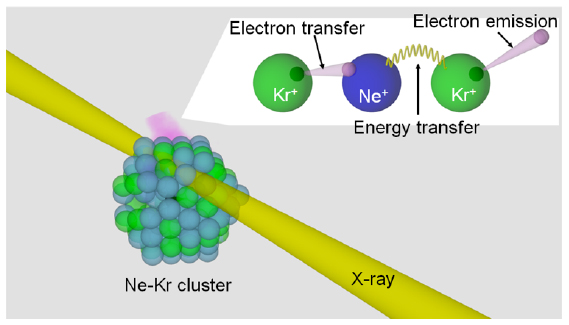How x-rays in matter create genetoxic low-energy electrons

Figure: Scientists have elucidated a novel mechanism of electron emission from matter caused by x-rays. In the studied model system, X-rays produce the doubly-charged particle (Ne2+), which catches an electron from one of the neighboring atoms (Kr), transferring the energy to the other and releasing another electron.
X-rays are one of the most important diagnostic tools in medicine, biology and the material sciences, as they may penetrate deep into material which is opaque to the human eye. Their passage through a sample, however, can have side effects, as the absorption of X-rays deposes energy in deep layers of the sample. In extreme cases, the application of X-rays is limited by these side effects, known as 'radiation damage'. Medicine is one area in which the absorbed X-ray dose must be minimized.
Surprisingly, it is unclear what happens when an X-ray is absorbed, for example, in biological tissue consisting of water, biomolecules and some metal atoms. One reason for this is that the first few steps of reactions after the absorption of an X-ray, happen extremely fast, within 10-100 femtoseconds. A femtosecond is the SI unit of time equal to 10−15. To put it another way, it's one millionth of one billionth of a second.
Within this time, in a complex cascade of events, several electrons are emitted, and positively charged reactive particles (ions) are created. Most experiments done up to now were only able to characterize this final state a long time after the cascading reaction was completed. However, it is the precise understanding of the intermediate steps that is very important for the prediction and design of radiation effects in matter.
The team has now carried out an experiment that took an unprecedented detailed view of the first few hundred fs after absorption of an X-ray by matter.
In a biological system, a lot of water molecules are flexibly arranged around the biologically functional molecules, without strongly binding to them.
As a model system for that, a flexible, weakly bonded aggregate of two different noble gases, Ne and Kr, was created by cooling them to extremely low temperatures. These Ne-Kr clusters were then exposed to pulsed X-rays of the SPring-8 synchrotron radiation source which, under the conditions chosen for the experiment, preferentially ionized Ne atoms.
By using an advanced experimental set-up, the team was able to record all electrons and ions that were created at every X-ray absorption event. They found that just a few hundred fs after the initial ionization, the Ne atom that had absorbed the x-ray, as well as two neighboring Kr atoms, were all in an ionized, positively charged state.
The mechanism by which this ultrafast charge redistribution proceeds, proposed theoretically by research team member Lorenz Cederbaum, has been named the 'Electron Transfer Mediated Decay' (ETMD). It consists of electron transfer to the originally ionized Ne atom matched by energy transfer away from the Ne, which leads to ionization of the second Kr atom nearby. The experiment clearly demonstrates that highly localized charge produced by X-rays in matter, redistributes over many atomic sites in a surprisingly short time.
Kiyoshi Ueda says: 'We believe that understanding X-ray initiated processes on a microscopic level will lead to new insights across the disciplines of physics, biology and chemistry.'
These results have been published in the scientific journal Nature Communications.
Contact:
Kiyoshi Ueda
Institute of Multidisciplinary Research for Advanced Materials
Email: ueda@tagen.tohoku.ac.jp
Tel: +81-22-217-5481
Associated links
Journal information
Title: Charge transfer to ground state ions produces free electrons
Authors: D. You, H. Fukuzawa, Y. Sakakibara, T. Takanashi, Y. It, G. G. Maliyar, K. Motomura, K. Nagaya, T. Nishiyama, K. Asa, Y. Sato, N. Saito, M. Oura,M. Schöffler, G. Kastirke, U. Hergenhahn, V. Stumpf, K. Gokhberg, A. I. Kuleff, L. S. Cederbaum & K. Ueda
Journal: Nature Communications 6, 14277 (2017).
DOI: 10.1038/NCOMMS14277
Media Contact
More Information:
http://www.researchsea.comAll latest news from the category: Physics and Astronomy
This area deals with the fundamental laws and building blocks of nature and how they interact, the properties and the behavior of matter, and research into space and time and their structures.
innovations-report provides in-depth reports and articles on subjects such as astrophysics, laser technologies, nuclear, quantum, particle and solid-state physics, nanotechnologies, planetary research and findings (Mars, Venus) and developments related to the Hubble Telescope.
Newest articles

New SPECT/CT technique shows impressive biomarker identification
…offers increased access for prostate cancer patients. A novel SPECT/CT acquisition method can accurately detect radiopharmaceutical biodistribution in a convenient manner for prostate cancer patients, opening the door for more…

How 3D printers can give robots a soft touch
Soft skin coverings and touch sensors have emerged as a promising feature for robots that are both safer and more intuitive for human interaction, but they are expensive and difficult…

Oxygen vacancies mediated ultrathin Bi4O5Br2 nanosheets
… as efficient piezocatalyst for synthesis of H2O2 from pure water. As an important chemical raw material, hydrogen peroxide (H2O2) is widely applied in various aspects of industry and life….





















